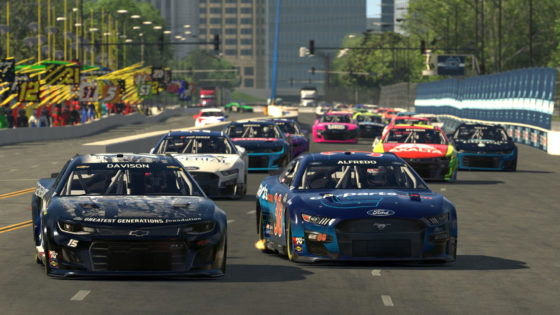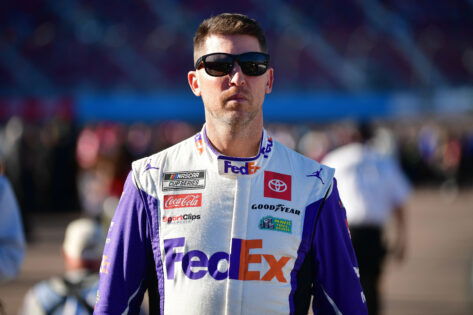Some are born into NASCAR. Think Dale Earnhardt Jr. or Kyle Petty. These guys were practically raised at the racetrack, following legendary last names onto pit road. Others climb in the old-school way, grinding it out on short tracks, loading up beat-up cars in trailers every weekend, just hoping for a shot. You’ll find a long list of names for that. Then there are the go-kart kids, the dirt specialists, the late bloomers who hustle their way up through grit and sheer persistence.
But lately, there’s been a new kind of door opening into NASCAR. And, surprisingly, it doesn’t involve tire smoke or grease-stained jeans. Rather, there’s a high-end gaming PC, a steering wheel clamped to a desk, and a digital version of Daytona. For a new wave of racers, including rising stars, the path to the big leagues isn’t paved in rubber. It’s rendered in pixels.
How iRacing is fueling NASCAR’s future
NASCAR is evolving. From going international to podium celebrations, the sport is definitely trying to keep up with the times. Among the changes, one particularly stands out – how drivers get an entry into the world of NASCAR. For decades, the road to NASCAR was lined with late-model stock cars, dusty bullrings, and relentless travel. But now, there’s a digital shortcut: iRacing.
Launched in 2008, iRacing is an advanced online racing simulation service that allows users to experience the thrill of motorsport from their own homes. What’s different about it from traditional video games? Well, iRacing offers laser-scanned replicas of real tracks, officially licensed cars, and a highly competitive environment where racers from around the globe compete in organized series and private leagues. Things are serious here!
The popularity of iRacing has soared in recent years, especially during the COVID-19 pandemic. Remember how back then, real-world motorsports were put on hold? During the same time, in 2020, iRacing’s active subscriber base surged by nearly 50%. It grew from 110,000 to over 160,000 members within a few months. This rapid growth was fueled by professional drivers, fans, and aspiring racers seeking a competitive outlet. Jog your memories to the eNASCAR iRacing Pro Invitational Series, which saw participation from Hall of Fame driver Dale Earnhardt Jr., who finished second to Denny Hamlin in the inaugural race at Homestead-Miami Speedway.
What sets iRacing apart is its role as a legitimate talent pipeline to NASCAR. The platform’s skill-based ranking system, known as iRating, allows drivers to progress through increasingly competitive fields. This mirrors the ladder system of real-world racing. As a result, iRacing has become a proving ground for young talent, offering a low-cost, accessible path to professional motorsports.
iRacing talents break through in NASCAR
Take Rajah Caruth and William Byron, for example. Rajah Caruth began his racing journey on iRacing before making history as one of the few Black drivers to win in a national NASCAR touring series. His sim racing background gave him the skills and confidence to transition to real-world competition.
Caruth tasted success in NASCAR in a breakthrough victory at Las Vegas Motor Speedway in the NASCAR Craftsman Truck Series in 2024. He also claimed the 2024 Most Popular Driver Award in the Truck series. This year, he built on last year’s performance with a win at Nashville, cementing his legitimacy as a worthy NASCAR driver. Well, he’s not content with truck racing; he is eyeing that next step towards Cup racing like his rival Corey Heim.
Then, there’s William Byron, too. Byron, now a star driver for Hendrick Motorsports, also started his career in iRacing. Here, he amassed over 100 wins and nearly 300 top-five finishes before moving to offline racing in 2012. His rapid ascent through the ranks culminated in multiple Cup Series race wins.
Byron currently sits at the top of the Cup Series drivers’ standings with 604 points, demonstrating how digital roots can lead to real-world NASCAR success. If anything, he is a genuine contender to lead HMS’s title charge this year as well, like he did in 2024. “What sim racing does is just gives a great avenue for people to get started,” Byron explained the possibilities unlocked through iRacing.
With drivers like Caruth and Byron leading the way, iRacing is no longer just a game. Instead, it’s a legitimate entry point into NASCAR’s elite ranks, reshaping how the next generation of drivers is discovered and developed. It will be interesting to see which new names rise through the ranks next. Not from dirt tracks or go-kart circuits, but from behind a screen, headset on, wheel in hand.
The post Inside the Sim: How iRacing Is Becoming NASCAR’s Next Driver Pipeline appeared first on EssentiallySports.



